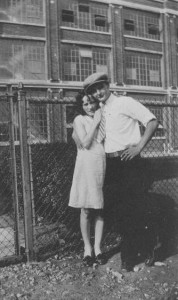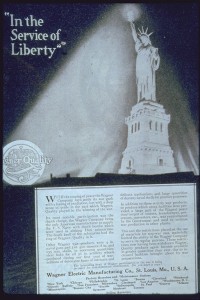Waging War at Wagner: Business Booms, Leaves Its Mark on a Community
In the early twentieth century, industry and business also began to thrive. Indeed, according to an encyclopedia published in 1901, the Wellston Loop was one of the “greatest Business Districts in Missouri.”
According to the City of St. Louis website, “Industrial activity in the northwestern industrial district [the part of St. Louis City in which parts of the Wellston community could be found] owes its development to the construction of the Terminal Railroad belt line about 1900. The convenience of rail access combined with plenty of adjacent vacant land resulted in the establishment of many industrial plants in the area.”
Wellston was one of the first suburban outgrowths of St. Louis and was one of the oldest industrial districts in the county. According to the St. Louis Post-Dispatch, in 1906 “a fast-growing motor producer identified the [Wellston] area . . . as the site for its new factory. Wagner Electric found access to railroad and public transportation as well as plenty of land. Other manufacturing firms followed Wagner to Wellston, including General Electric, which in 1911 established a light-bulb plant.”
By the mid-20th century, companies in the Wellston area included Fulton Iron Works, Mazda Electric, Vi-Jon Laboratories, Moog Industries, Curtis Manufacturing, and of course Wagner Electric, which continued to be a major employer, providing jobs for 6,000 workers at its height in the mid-1950s.
Student editors of the 1950 Welhisco wrote, “In Our Town are found a number of prosperous industrial

Marie and Arthur Landsbury in front of the Wagner Electric Manufacturing Plant, where they were both employed (collection of Bonnie Burrows)
plants. A bustling crowd comes and goes on the streets where retail shops are found and proves that Wellston is a vigorous and prosperous business center.” The busy employment at Wellston area factories was a crucial component of the community’s hustle and bustle.
Eventually, like so many other industrial companies, Wagner Electric began to look for new plant locations – places where labor could be had at cheaper rates. “Employment declines,” says the St. Louis Post-Dispatch, “and by 1980, Wagner Electric was down to about 1,500 workers in Wellston.”
When Wagner finally closed its Wellston plant in 1983, it donated its 55-acre site to St. Louis County and got a $3 million tax credit in exchange.
But it also left behind a legacy of toxic waste. PCBs (polychlorinated biphenyls) were discovered on the site, and although Wagner ultimately paid St. Louis County $2 million, the site remained contaminated. No businesses wanted to purchase and renovate the factory – and it fell steadily into disrepair.
A ground-breaking 1997 study examined the role that environmental justice and urban geography played in the “Fiasco at Wagner Electric” (A. Hurley, Environmental History 2.4: 460-481).
For many years, those who saw the old Wagner factory – whether visiting it in person or viewing it from the comfort of a MetroLink car – described it as a bombed-out remnant of industrial battle. The St. Louis Post-Dispatch notes, that by the mid-1990s, “the buildings were covered in graffiti, and some walls were missing. The site was overgrown with weeds. Plastic was flying out of the windows.”
Recently, the Wagner building has been restored and is now the site of the Metropolitan Education and Training Center.
Next.
